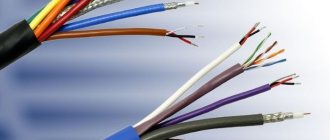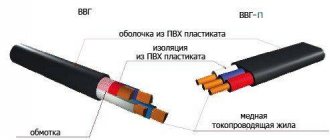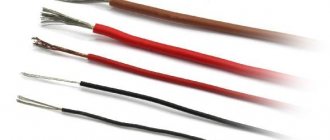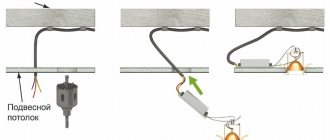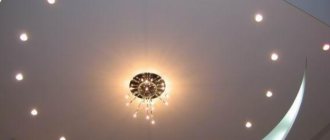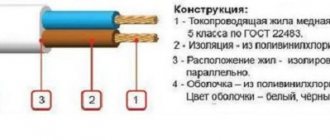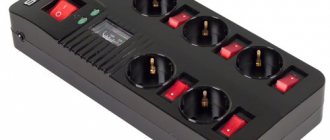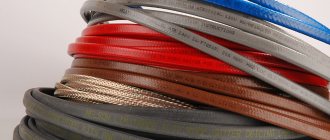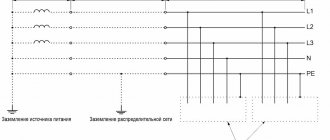Category: interesting things about fishing Tags: test units of measurement cord fishing line fluorocarbon
Each type of fishing requires its own fishing line or cord. Particularly important is the choice of its size, and to be more precise, its thickness. It would seem that what is so difficult about this? But most cords have #PE, not millimeters, as their main parameter. What is the diameter of PE? In this article I will tell you everything about the Japanese numbering of fishing lines and braided cords , and also in the table I will show the conversion of PE diameter in mm.
What is a PEN conductor
If 2 wires go from a pole to a house, then one of them is L - phase, and the second is a PEN conductor.
PEN – combined neutral working conductor with neutral protective conductor.
N – zero working conductor (neutral).
PE - neutral protective conductor (grounding, equalizing potentials) - appears in the circuit after dividing the PEN wire, or is taken directly from the ground loop.
PE + N = PEN
Connected at the transformer substation, used in TN-C grounding systems.
According to the PUE - rules for the design of electrical installations, TN-C means a system grounded to neutral with combined protective and working conductors.
Despite its widespread use in apartment buildings, the TN-C system is outdated and is gradually being replaced by more advanced TN-S or TN-CS systems.
Designation L and N in electrics
Let's figure out what the designations L and N mean in electrical engineering.
As you probably guessed, these are not just arbitrary symbols, each of them carries a specific meaning and serves as a hint for correctly connecting the electrical appliance to the network.
“ L ” - This marking came to electrical engineering from the English language, and it is formed from the first letter of the word “Line” (line) - the generally accepted name for a phase wire. Also, if it is more convenient for you, you can focus on such concepts of English words as Lead (lead wire, core) or Live (under voltage).
Accordingly, the designation L marks the clamps and contact connections intended for connecting the phase wire. In a three-phase network, alphanumeric identification (marking) of phase conductors “L1”, “L2” and “L3”.
According to modern standards (GOST R 50462-2009 (IEC 60446:2007)) in force in Russia, the colors of phase wires are brown or black. But often, white, pink, gray or a wire of any other color except blue, white-blue can be found , blue, white-blue or yellow-green.
“N” is a marking formed from the first letter of the word Neutral (neutral) - the generally accepted name for the neutral working conductor, in Russia more often called simply the neutral conductor or briefly Zero (Zero). In this regard, the English word NULL (zero) is well suited, you can focus on it.
the designation N marks clamps and contact connections for connecting the neutral working conductor/neutral wire. Moreover, this rule applies to both single-phase and three-phase networks.
The colors of the wire that mark the neutral wire (zero, zero, zero working conductor) are strictly blue (light blue) or white-blue (white-blue).
If we are talking about the designations L and N in electrical engineering, we cannot help but note this sign - , which can also almost always be seen together with these two markings. This icon marks clamps, terminals or contact connections for connecting a protective grounding wire ( PE - Protective Earthing), also known as a neutral protective conductor, grounding, earth.
The generally accepted color marking of the neutral protective wire is yellow-green. These two colors are reserved only for ground wires and are not used to designate phase or neutral wires.
Unfortunately, often the electrical wiring in our apartments and houses is not carried out in compliance with all strict standards and rules for color and alphanumeric markings for electricians. And knowing the purpose of the L and N markings on electrical equipment is sometimes not enough for proper connection. Therefore, be sure to read our article “How to determine phase, zero and grounding yourself, using improvised means?” If you have any doubts, this material will come in handy.
PEN conductor separation
Why split the PEN conductor? According to PUE-7
7.1.13. Electrical receivers must be powered from a 380/220 V network with a TN-S or TN-C-S grounding system. When reconstructing residential and public buildings with a network voltage of 220/127 V or 3 x 220 V, it is necessary to provide for transferring the network to a voltage of 380/220 V with a TN-S or TN-C-S grounding system.
We already know that in many houses the electrical wiring is made according to outdated standards with a TN-C grounding system, and in order to transfer the network to TN-S or TN-C-S it is necessary to divide the PEN into zero working and zero protective conductors.
Rules for separating PEN conductor
1. The separation of the PEN conductor is carried out in the input distribution device.
Splitting a PEN wire in a floor panel is a gross violation of the existing house power supply design. You cannot interfere with the existing scheme!
2. From the point where PEN is divided into N and PE conductors, their further connection is prohibited.
3. After separation, the tires are considered different and are marked accordingly:
- N - blue.
- PE - yellow-green.
4. Between the PE and N busbars there must be a jumper with a cross-section no smaller than the busbars themselves.
Important! Grounding is always placed first and a jumper goes from it to the working zero.
5. The PE conductor bus must be grounded and in contact with the transformer body.
6. Bus N is installed on insulators - it should not be in contact with the housing.
Why do you need a jumper between PE and N buses?
The jumper is required for the input circuit breaker to operate. If there is no jumper and the phase hits the equipment body, the current will go to the ground and not to the transformer.
If we take the average value of the resistance of the grounding chain to be 20 ohms, the leakage current will not be enough to trip the circuit breaker. The circuit will continue to function until the damaged section burns out or a full short circuit occurs. This situation may result in electric shock, equipment damage and fire.
In this case, an RCD - a residual current device - will help, but you should not rely on it alone; two-factor protection will be required - without it, the connection will not be accepted by energy supervision. It is recommended to install an RCD in any case.
Power connectors ABB 2P+3P+E+N
| ABB CEW Surface Mount Plug series 416-463 contacts 3P+N+E, 380-415V (50-60Hz). Protection degree IP44 | 16-32A | 16-32A | 63A | 63A |
| Current strength | 16A | 32A | ||||
| Number of contacts | 2 (3P+E) | 3 (3P+E), 5 (3P+N+E) | 3 (2P+E), 4 (3P+E) | 5 (3P+N+E) | ||
| dimensions | B | 66 | 79 | 79 | 85 | 85 |
| C | 75 | 91 | 91 | 111 | 111 | |
| C1 | 54 | 67 | 67 | 72 | 72 | |
| Dmax | 18/M20 | 18/M20 | 18/M20 | 22/M25 | 22/M25 | |
| E1 | 72 | 78 | 81 | 94 | 94 | |
| F | 5,50 | 5,50 | 5,50 | 5,50 | 5,50 | |
| H | 110 | 124 | 125 | 153 | 154 | |
| Surface mount socket ABB CEW series 416-463 contacts 3P+N+E, 380-415V (50-60Hz). Protection degree IP44 | 16-32A | 16-32A | 63A | 63A |
| Current strength. | 16A | 32A | 63A | ||||
| Number of contacts | 3 (2P+E) | 4 (3P+E), 5 (3P+N+E) | 2 (3P+E), 3 (3P+E), 5 (3P+N+E) | 5 (3P+N+E) | 2 (3P+E), 3 (3P+E), 5 (3P+N+E) | ||
| dimensions | A | 91 | 100 | 104 | 118 | 116 | 136 |
| B | 117 | 132 | 134 | 163 | 163 | 254 | |
| C | 75 | 91 | 91 | 111 | 111 | 170 | |
| C1 | 54 | 67 | 67 | 72 | 72 | 95 | |
| D | 18/M20 | 18/M20 | 18/M20 | 22/M25 | 22/M25 | M32 | |
| E | 66 | 79 | 79 | 85 | 85 | 107 | |
| F | 5,50 | 5,50 | 5,50 | 5,50 | 5,50 | 5,20 | |
If you are interested in our products, call: (499) 290-30-16 (mngk), 740-42-64, 973-65-17 or send a request by email
We will provide competitive prices for ABB 2P+3P+E+N Power connectors
Write to [email protected]
| Name | Brief characteristics | Manufacturer | Unit | Price with VAT |
| Cable plug 16A 2P+E IP44 2CMA193501R1000 | plug 16A ABB 2CMA193501R1000 | ABB | Thing | 222,00 |
| Cable plug 16A 3P+E IP44 2CMA193506R1000 | plug 16A ABB 2CMA193506R1000 | ABB | Thing | 228,67 |
| Cable plug 16A 3P+N+E IP44 2CMA193511R1000 | plug 16A ABB 2CMA193511R1000 | ABB | Thing | 225,33 |
| Cable plug 16A 2P+E IP67 2CMA166460R1000 | plug 16A ABB 2CMA166460R1000 | ABB | Thing | 494,40 |
| Cable plug 16A 3P+N+E IP67 2CMA166494R1000 | plug 16A ABB 2CMA166494R1000 | ABB | Thing | 694,66 |
| Cable plug 32A 3P+N+E IP67 2CMA166524R1000 | plug 32A ABB 2CMA166524R1000 | ABB | Thing | 1 038,19 |
| Cable plug 32A 2P+E IP44 2CMA193513R1000 | plug 32A ABB 2CMA193513R1000 | ABB | Thing | 310,46 |
| Cable plug 32A 3P+N+E IP44 2CMA193519R1000 | plug 32A ABB 2CMA193519R1000 | ABB | Thing | 347,18 |
| Cable plug 63A 3P+E IP44 2CMA166752R1000 | plug 63A ABB 2CMA166752R1000 | ABB | Thing | 1 932,23 |
| Cable plug 63A 3P+N+E IP44 2CMA166764R1000 | plug 63A ABB 2CMA166764R1000 | ABB | Thing | 1 570,64 |
| Cable plug 63A 3P+N+E IP67 2CMA166798R1000 | plug 63A ABB 2CMA166798R1000 | ABB | Thing | 1 999,60 |
| Cable plug 125A 3P+N+E IP67 2CMA166828R1000 | plug 125A ABB 2CMA166828R1000 | ABB | Thing | 5 534,79 |
| Panel socket straight 16A 2P+E IP44 2CMA193170R1000 | socket 16A ABB 2CMA193170R1000 | ABB | Thing | 489,71 |
| Panel socket straight 16A 3P+N+E IP44 2CMA193187R1000 | socket 16A ABB 2CMA193187R1000 | ABB | Thing | 583,58 |
| Panel socket 32A 3P+N+E IP44 2CMA193259R1000 | socket 32A ABB 2CMA193259R1000 | ABB | Thing | 860,51 |
| Cable socket 16A 2P+E IP44 2CMA193521R1000 | socket 16A ABB 2CMA193521R1000 | ABB | Thing | 300,44 |
| Cable socket 16A 3P+E IP44 2CMA193523R1000 | socket 16A ABB 2CMA193523R1000 | ABB | Thing | 377,06 |
| Cable socket 16A 3P+N+E IP44 2CMA193526R1000 | socket 16A ABB 2CMA193526R1000 | ABB | Thing | 325,47 |
| Cable socket 16A 2P+E IP67 2CMA166538R1000 | socket 16A ABB 2CMA166538R1000 | ABB | Thing | 694,66 |
| Cable socket 16A 3P+N+E IP67 2CMA166572R1000 | socket 16A ABB 2CMA166572R1000 | ABB | Thing | 935,61 |
| Cable socket 32A 2P+E IP44 2CMA193528R1000 | socket 32A ABB 2CMA193528R1000 | ABB | Thing | 467,36 |
| Cable socket 32A 3P+N+E IP44 2CMA193531R1000 | socket 32A ABB 2CMA193531R1000 | ABB | Thing | 482,39 |
| Cable socket 32A 3P+N+E IP67 2CMA166618R1000 | socket 32A ABB 2CMA166618R1000 | ABB | Thing | 1 400,39 |
| Surface mount socket 32A 3P+N+E IP67 2CMA167189R1000 | socket 32A ABB 2CMA167189R1000 | ABB | Thing | 1 660,76 |
| Cable socket 2A 3P+E IP44 2CMA193529R1000 | socket 32A ABB 2CMA193529R1000 | ABB | Thing | 638,34 |
| Cable socket 63A 3P+E IP44 2CMA166850R1000 | 63A socket ABB 2CMA166850R1000 | ABB | Thing | 2 252,97 |
| Cable socket 63A 3P+N+E IP44 2CMA166862R1000 | 63A socket ABB 2CMA166862R1000 | ABB | Thing | 1 772,60 |
| Cable socket 63A 3P+N+E IP67 2CMA166906R1000 | 63A socket ABB 2CMA166906R1000 | ABB | Thing | 2 605,49 |
| Outdoor socket 16A 2P+E IP44 2CMA193098R1000 | socket 16A ABB 2CMA193098R1000 | ABB | Thing | 378,89 |
| Outdoor socket 16A 3P+N+E IP44 2CMA193115R1000 | socket 16A ABB 2CMA193115R1000 | ABB | Thing | 415,60 |
| Outdoor socket 16A 3P+E IP44 2CMA193106R1000 | socket 16A ABB 2CMA193106R1000 | ABB | Thing | 403,93 |
| Outdoor socket 16A 3P+N+E IP67 2CMA167166R1000 | socket 16A ABB 2CMA167166R1000 | ABB | Thing | 1 186,74 |
| Outdoor socket 32A 3P+N+E IP44 2CMA193139R1000 | socket 32A ABB 2CMA193139R1000 | ABB | Thing | 615,79 |
| Outdoor socket 32A 2P+E IP44 ABB 2CMA193122R1000 | socket 32A ABB 2CMA193122R1000 | ABB | Thing | 532,46 |
| Outdoor socket 32A 3P+E IP44 2CMA193130R1000 | socket 32A ABB 2CMA193130R1000 | ABB | Thing | 570,83 |
| Outdoor socket 63A 3P+E IP44 2CMA167498R1000 | 63A socket ABB 2CMA167498R1000 | ABB | Thing | 2 769,27 |
| Outdoor socket 63A 3P+N+E IP44 2CMA167484R1000 | 63A socket ABB 2CMA167484R1000 | ABB | Thing | 2 803,69 |
| Outdoor socket 125A 3P+N+E IP67 2CMA167264R1000 | socket 125A ABB 2CMA167264R1000 | ABB | Thing | 5 312,81 |
If you are interested in our products, call: (499) 290-30-16 (mngk), 740-42-64, 973-65-17 or send a request by email
Connecting a PEN conductor in a private house
In a private house or cottage, it is quite simple to organize a grounding system, but there is a need for phase protection from overvoltage and lightning protection. In this case, a “fire” and selective residual current device is required. Splitting the PEN neutral conductor is not a problem and should be done everywhere.
Energy regulators may require that the PEN conductor be separated after the electricity meter. This is done to prevent electricity theft. Such a connection is acceptable, but it would be correct to separate it before the meter, it will be more reliable. Watch the video of a professional:
The PUE requirements provide comprehensive recommendations on the issue of separating the PEN conductor, regardless of the location and method of connection, study and apply. Good luck with business!
Is there anything to add to the material? LEAVE A COMMENT
Japanese numbering of lines and cords
Why and for what purpose are these incomprehensible designations needed? This question has always tormented me. But in fact, what is not particularly common for us, especially seeing the cord size not in understandable millimeters, but in some #PE, is quite common in Japan. Moreover, most fishing trends or new products originate in this country and therefore you will have to adapt to them.
Japanese numbering of fishing lines and cords has long roots, which originated in the numbering of silk threads. Now the #PE dimension can be found not only on braided PE cords, but also on fluorocarbon, nylon and polyester fishing lines.
Sometimes the manufacturer indicates on the box or spool of fishing line its diameter in mm, but sometimes you may not see this. In any case, there is nothing terrible about this. If you have been interested in fishing and tackle for at least a year or two, you will easily get used to the Japanese numbering of cords, and there will be no need to look at the thickness in millimeters. PE numbering is marked with a # before the number.
